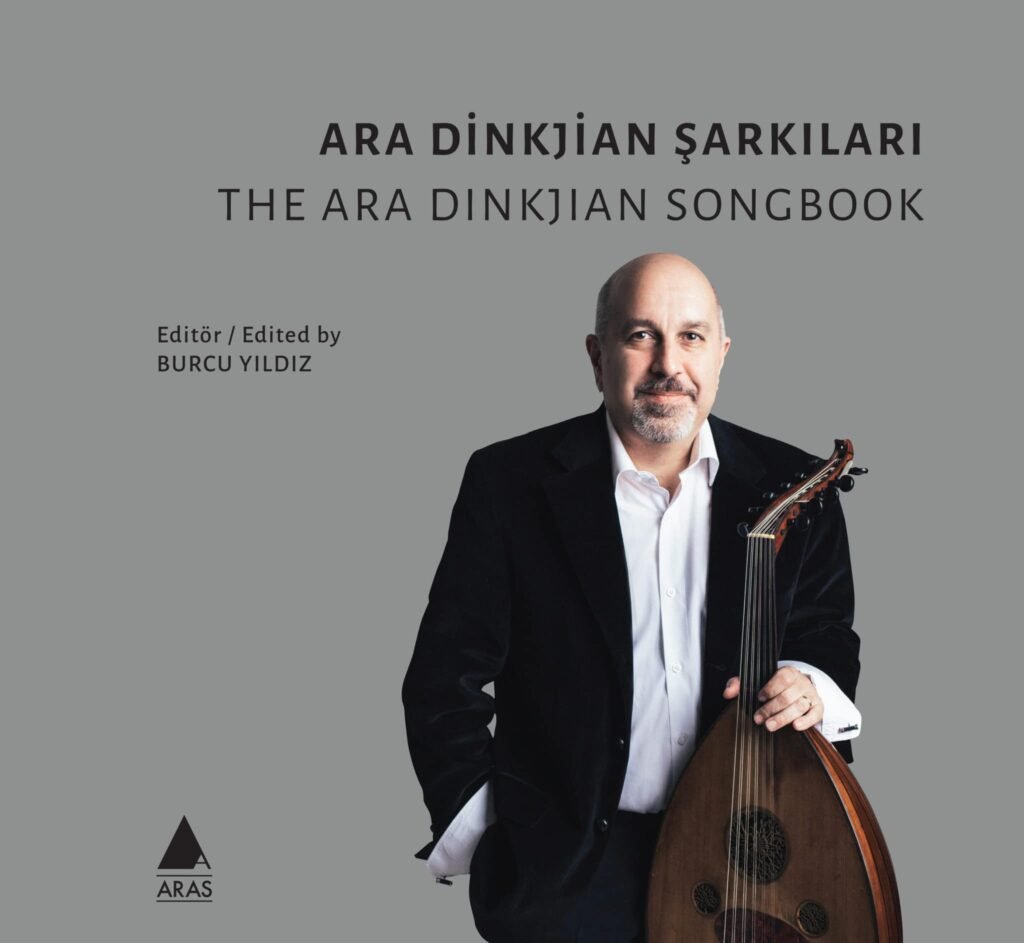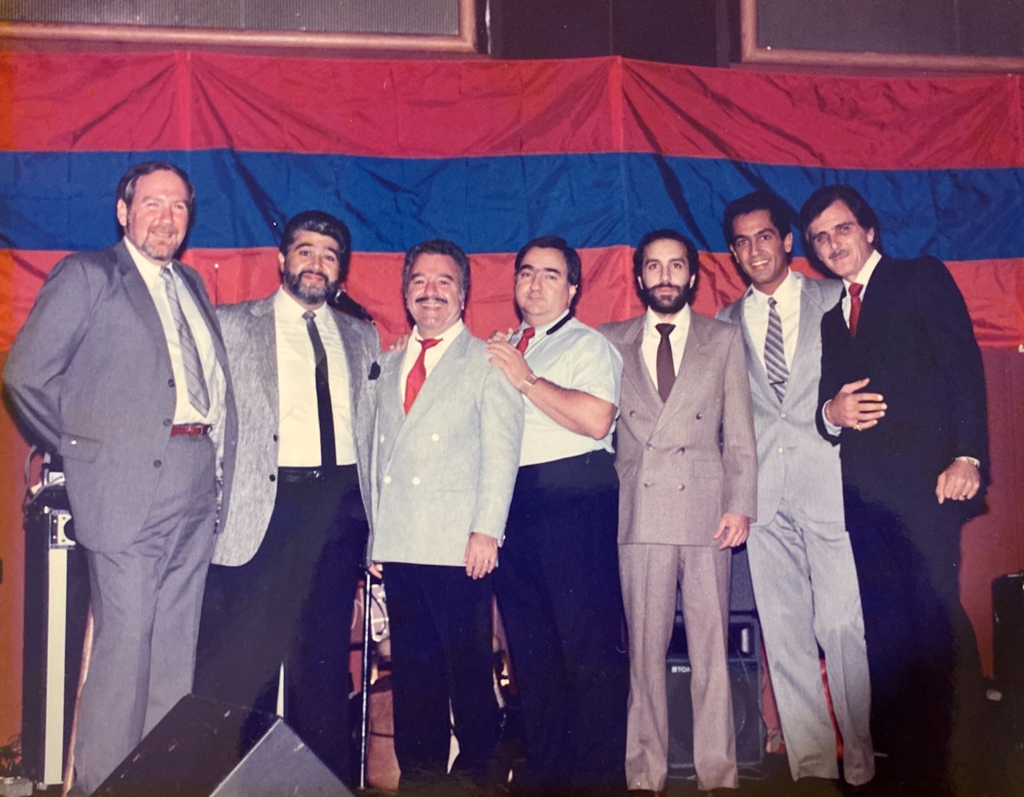 Earlier this month, I read the following post from Ara Dinkjian on Facebook:
Earlier this month, I read the following post from Ara Dinkjian on Facebook:
Dear Friends,
Over the years, I’ve received many requests for sheet music to some of my compositions. I am proud to announce that the good folks at Aras Publishing (founded in 1993 in Istanbul by Hrant Dink, Mgrdich Margosyan and Edward Tovmasyan) have just released The Ara Dinkjian Songbook, which includes the sheet music for all of my compositions, as well as my biography written by editor Burcu Yildiz. For further information, you can email Aras Publishing at: info@arasyayincilik.com
My first thought was, “Good for Ara.” My immediate next thought was, “I have to get this book.”
I ordered it via Amazon, fulfilled by Abril Bookstore, and it arrived on March 22. I opened the box and pulled out the beautifully designed and crafted book that is in both Turkish and English. I admired the elegant cover photo of Ara holding his 1903 Manol oud.
I first looked for my four favorite Ara Dinkjian songs that I play: “Anna Tol’ Ya,” “Homecoming,” “Offering” and “Picture.” I learned these tunes in the tradition of Armenian kef bands in the US, which is to say by ear. It was really nice to study the sheet music to see how Ara actually wrote the music versus my interpretation of them.

Ara’s Facebook announcement said the book included a biography. For some reason, I expected five, maybe 10 pages. It was a pleasant surprise to find a 74-page biography. I immediately started reading it and was even more pleasantly surprised at the content. Burcu Yildiz is the editor of this book and wrote and compiled a most excellent bio of Ara.
Yildiz is a fabulous singer having performed both with Ara, Kardes Turkuler and more. In speaking with Ara, he told me she is a scholar and professor as well. She is an expert on Gomidas and performs his songs in Armenian. I will add that she is a gifted writer who wrote the text in both languages. It is worth getting The Ara Dinkjian Songbook simply for her wonderful biography, which includes details of Ara’s musical life and insights into how he became such a gifted musician and composer. There are many quotes from Ara. We get to understand just how central music is in his life. He started by teaching himself to play his father’s oud at the age of six. We get a glimpse of the kind of top-notch professional musician he is and how he meticulously prepares for each performance and recording session and expects the same from others.
Ara Dinkjian went into Hartt School of Music as a music education major. At first, he did not find this at all fulfilling and as Yildiz wrote:
He went to the dean’s office and said that he wanted to leave school; he dreamed of a career centered around composition or performance, not teaching. Fortunately, the dean told him that he needed to take advantage of the opportunity they had given him and asked him to come up with a proposal for a four-year oud program…In this way, he became the first student in the United States to complete an oud degree program.
The biography covers his musical performance history including his first band Night Ark, his collaborations with Sezen Aksu and Eleftheria Arvanitaki, his performances in Dikranagerd and Istanbul with his father, and his current group The Secret Trio. There are testimonials from ethnomusicologist Dr. Melissa Bilal, famed kanun player Tamer Pinarbasi, oudist Fatih Ahiskali, as well as Ara’s wife Margo and his youngest daughter Arev. Arev’s words came directly from her beautiful article “My Father’s Music Room,” published on June 28, 2020 in the Armenian Weekly.
[RELATED: Garod, a documentary about Onnik and Ara Dinkjian, directed by Onur Gunay and Burcu Yildiz]
I am not sure if we can separate Ara’s playing from his music. His songs, to some debatable degree, are written in his unique style of playing. As Yildiz wrote:
In his own words, neither the way he sits, nor how he holds his oud, places his fingers, uses the plectrum, uses the thumb of his left hand and crosses his legs, are appropriate in the eyes of any oud teacher.
No one sits like Ara and angles the oud on his lap like he does. He uses the upstroke of the plectrum more effectively than any other oud player. He said that “he feels a certain control when playing the upstroke.” He went on to tell me that he focuses on the ring and tone of each individual note. As a result, he plays in a very measured and deliberate way that is also very fluid and flowing. He also has a unique trilling style. When he plays a taksim, any student of the music immediately recognizes that it is Ara playing based on the pacing, spacing of notes and the aforementioned techniques. To see what I am trying to convey, watch Ara play his composition “Keesher Bar.”
Don’t think for a moment that his style limits him in any way to taksims or slower, soulful pieces. Ara is very measured, deliberate, accurate and fluid with any challenging piece no matter the speed or complexity (e.g. “For Alexis,” composed by Ara).
When I first heard Fatih Ahiskali play the oud many years ago, I heard Ara’s influence in his playing. I called Ara who confirmed they were friends but, as is Ara’s nature, he took little credit. In this book, Ahiskali noted that:
Ara Dinkjian was a breaking point in my oud playing… Ara Dinkjian made me aware of getting a good tone as a priority… he is the only oudist whose heart I can truly hear in his music.
Ara classifies music into two categories: the music that we have playing in the background to whatever we are doing and the music that changes the perceptions of where you are. Ara’s compositions and recordings are definitely in the second category. My proof of this is simple. Naturally, I was listening to Ara’s recordings while writing this review. It took me six times longer to write it than normal just because my focus was drawn from typing to being engrossed in the music.
Ara played The Jerusalem Oud Festival in 2005 and 2006 from which the live albums, “An Armenian in America” and “Peace on Earth,” were recorded. Zohar Fresco, the percussionist for the performances, wrote perhaps the perfect description of Ara’s compositions:
I can’t remember when I heard Ara Dinkjian’s music for the first time; his haunting, tender melodies, sounded like they’d always been there, and I couldn’t imagine life without them.
Indeed, his compositions are haunting and tender melodies. Since they come from Ara’s heart, soul and from his very DNA, they do sound like they have always been there. They define something unique to the place where we, Armenians, came from. It is a je ne sais quoi that speaks of the land, waters and mountains and our collective ingrained memory, making them perhaps more tender and haunting to those of us scattered in the diaspora. Ara has this very view of the music he composes. He is humble, but very philosophical about it.
When it comes to Ara’s music, this phenomenon of touching the core of our beings is not unique to Armenians. It applies across many ethnicities witnessed by the recordings of his songs with added vocals from Turkey and Greece, to Israel and around the world. Musicians and listeners from all over the world value these qualities in Ara’s compositions.
Thankfully, these compositions are compiled in The Ara Dinkjian Songbook from Aras Publishing.
How does one get the book? At the time of this writing, it is a bit hard to get. I am told that will change shortly. Keep checking Amazon and social media.


Excellent article Mark. It captures the spirit of Ara’s work and provides background and information about his musical odyssey. It also includes coverage of other oud performers and composers.